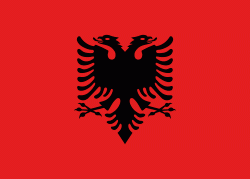Ksamil
Ksamil (Ksamili, Εξαμίλι) is a village and a former municipality in the riviera of Southern Albania, and part of Butrint National Park. At the 2015 local government reform it became a subdivision of the municipality Sarandë. The population at the 2011 census was 2,994; while according to the Civil Offices it was 9,220. The municipal unit consists of the villages Ksamil and Manastir. During the communist era, the coastal village of Ksamil was built in 1966 and is located south of the city of Sarandë off the road to Butrint.
Ksamil is one of the most frequented coastal resorts by both domestic and foreign tourists. Ksamil Beach and Albania's Ionian Coast further north was included in the Guardian's 20 of the best bargain beach holidays for 2013. The main attractions are the nearby Ksamil Islands. The Caribbean white sand beaches in Ksamil gave the town great tourist boost. Albanians from Kosovo and other Albanian-speaking areas visited Ksamil in recent years, but more and more international tourists are visiting the beach. This leads, for example, to new hotel facilities, but also to more expensive prices. Other activities are the Blue Eye in Muzinë, the Butrint National Park, Saranda and as well some other minor beaches that lie north to Ksamil.
During communism, the area became well known for the production of olive oil, lemons, and tangerines. In 2010, national authorities demolished over 200 illegal structures that violated the town's master plan and the integrity of Butrint National Park. Some remains from the demolished buildings have yet to be removed by authorities.
In 1992, the village of Ksamil was inhabited by a mixed population of Muslim Albanians (1125), Orthodox Albanians (210) and Greeks (520).
According to official estimates (2014) the population of the commune of Ksamil numbered 9,215, of whom 4,207 were members of the Greek minority, seven of the Aromanian minority, and the rest Albanians.
Ksamil is one of the most frequented coastal resorts by both domestic and foreign tourists. Ksamil Beach and Albania's Ionian Coast further north was included in the Guardian's 20 of the best bargain beach holidays for 2013. The main attractions are the nearby Ksamil Islands. The Caribbean white sand beaches in Ksamil gave the town great tourist boost. Albanians from Kosovo and other Albanian-speaking areas visited Ksamil in recent years, but more and more international tourists are visiting the beach. This leads, for example, to new hotel facilities, but also to more expensive prices. Other activities are the Blue Eye in Muzinë, the Butrint National Park, Saranda and as well some other minor beaches that lie north to Ksamil.
During communism, the area became well known for the production of olive oil, lemons, and tangerines. In 2010, national authorities demolished over 200 illegal structures that violated the town's master plan and the integrity of Butrint National Park. Some remains from the demolished buildings have yet to be removed by authorities.
In 1992, the village of Ksamil was inhabited by a mixed population of Muslim Albanians (1125), Orthodox Albanians (210) and Greeks (520).
According to official estimates (2014) the population of the commune of Ksamil numbered 9,215, of whom 4,207 were members of the Greek minority, seven of the Aromanian minority, and the rest Albanians.
Map - Ksamil
Map
Country - Albania
 |
 |
| Flag of Albania | |
Albania has been inhabited by different civilisations over time, such as the Illyrians, Thracians, Ancient Greeks, Romans, Byzantines, Venetians, and Ottomans. The Albanians established the autonomous Principality of Arbër in the 12th century. The Kingdom of Albania and Principality of Albania formed between the 13th and 14th centuries. Prior to the Ottoman conquest of Albania in the 15th century, the Albanian resistance to Ottoman expansion into Europe led by Skanderbeg won them acclaim over most of Europe. Albania remained under Ottoman rule for nearly five centuries, during which many Albanians (known as Arnauts) attained high-ranking offices in the empire, especially in the Southern Balkans and Egypt. Between the 18th and 19th centuries, cultural developments, widely attributed to Albanians having gathered both spiritual and intellectual strength, conclusively led to the Albanian Renaissance. After the defeat of the Ottomans in the Balkan Wars, the modern nation state of Albania declared independence in 1912. In the 20th century, the Kingdom of Albania was invaded by Italy, which formed Greater Albania before becoming a protectorate of Nazi Germany. Enver Hoxha formed the People's Socialist Republic of Albania after World War II, modeled under the terms of Hoxhaism. The Revolutions of 1991 concluded the fall of communism in Albania and eventually the establishment of the current Republic of Albania.
Currency / Language
| ISO | Currency | Symbol | Significant figures |
|---|---|---|---|
| ALL | Albanian lek | L | 2 |
| ISO | Language |
|---|---|
| SQ | Albanian language |
| EL | Greek language |















